Potrebujeme váš súhlas na využitie jednotlivých dát, aby sa vám okrem iného mohli ukazovať informácie týkajúce sa vašich záujmov. Súhlas udelíte kliknutím na tlačidlo „OK“.
ASTM E1247-12
Standard Practice for Detecting Fluorescence in Object-Color Specimens by Spectrophotometry
Automaticky preložený názov:
Štandardná prax pre detekciu fluorescencie v objektovo farieb vzoriek spektrofotometricky
NORMA vydaná dňa 1.7.2012
Informácie o norme:
Označenie normy: ASTM E1247-12
Poznámka: NEPLATNÁ
Dátum vydania normy: 1.7.2012
Kód tovaru: NS-40998
Počet strán: 4
Približná hmotnosť: 12 g (0.03 libier)
Krajina: Americká technická norma
Kategória: Technické normy ASTM
Kategórie - podobné normy:
Anotácia textu normy ASTM E1247-12 :
Keywords:
fluorescence, light-transmission and reflection, spectrophotometry, transmittance and reflectance, ICS Number Code 17.180.20 (Colours and measurement of light)
Doplňujúce informácie
| Significance and Use | ||||||||||||||||||||||
|
Several standards, including Practices E991, E1164, and Test Methods E1331, E1348 and E1349, require either the presence or absence of fluorescence exhibited by the specimen for correct application. This practice provides spectrophotometric procedures for identifying the presence of fluorescence in materials. This practice is applicable to all object-color specimens, whether opaque, translucent, or transparent, meeting the requirements for specimens in the appropriate standards listed in 2.1. Translucent specimens should be measured by reflectance, with a standard non-fluorescent backing material, usually but not necessarily black, placed behind the specimen during measurement. This practice requires the use of a spectrophotometer in which the spectral distribution of the illumination on the specimen can be altered by the user in one of several ways. The modification of the illumination can either be by the insertion of optical filters between the illuminating source and the specimen, without interfering with the detection of the radiation from the specimen, or by interchange of the illuminating and detecting systems of the instrument or by scanning of both the illuminating energy and detection output as in the two-monochromator method. The confirmation of the presence of fluorescence is made by the comparison of spectral curves, color difference, or single parameter difference such as ΔY between the measurements. Note 2—In editions of E1247 - 92 and earlier, the test of fluorescence was the two sets of spectral transmittances or radiance factor (reflectance factors) differ by 1 % of full scale at the wavelength of greatest difference. Either bidirectional or hemispherical instrument geometry may be used in this practice. The instrument must be capable of providing either broadband (white light) irradiation on the specimen or monochromatic irradiation and monochromatic detection. This practice describes methods to detect the presence of fluorescence only. It does not address the issue of whether the fluorescence makes a significant or insignificant contribution to the colorimetric properties of the specimen for any given application. The user must determine the practical significance of the effect of fluorescence on the color measurement. |
||||||||||||||||||||||
| 1. Scope | ||||||||||||||||||||||
|
1.1 This practice provides spectrophotometric methods for detecting the presence of fluorescence in object-color specimens. Note 1—Since the addition of fluorescing agents (colorants, whitening agents, etc.) is often intentional by the manufacturer of a material, information on the presence or absence of fluorescent properties in a specimen may often be obtained from the maker of the material. 1.2 This practice requires the use of a spectrophotometer that both irradiates the specimen over the wavelength range from 340 to 700 nm and allows the spectral distribution of illumination on the specimen to be altered as desired. 1.3 Within the above limitations, this practice is general in scope rather than specific as to instrument or material. 1.4 This standard does not purport to address all of the safety concerns, if any, associated with its use. It is the responsibility of the user of this standard to establish appropriate safety and health practices and determine the applicability of regulatory limitations prior to use. |
||||||||||||||||||||||
| 2. Referenced Documents | ||||||||||||||||||||||
|
Podobné normy:
Historická
1.11.2011
Historická
1.6.2008
Historická
1.11.2011
Historická
1.1.2013
Historická
1.7.2010
Historická
1.5.2013



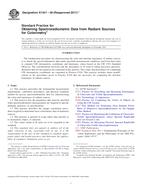 ASTM E1341-06(2011)e..
ASTM E1341-06(2011)e..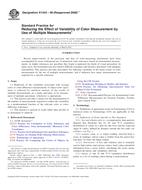 ASTM E1345-98(2008)e..
ASTM E1345-98(2008)e..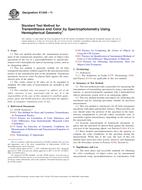 ASTM E1348-11
ASTM E1348-11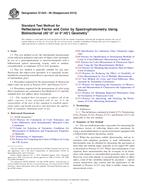 ASTM E1349-06(2013)..
ASTM E1349-06(2013)..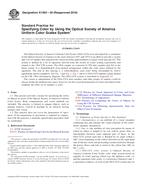 ASTM E1360-05(2010)..
ASTM E1360-05(2010)..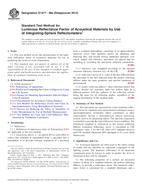 ASTM E1477-98a(2013)..
ASTM E1477-98a(2013)..
 Cookies
Cookies
